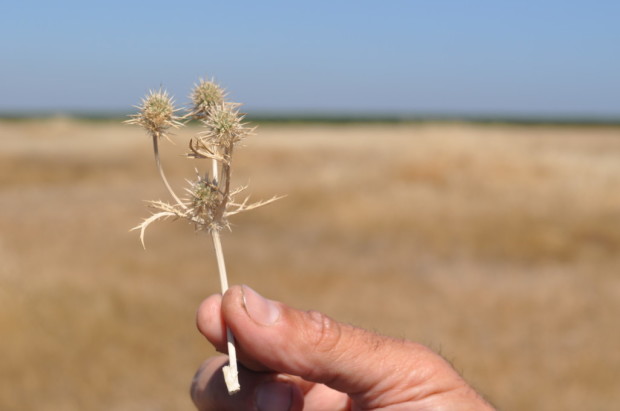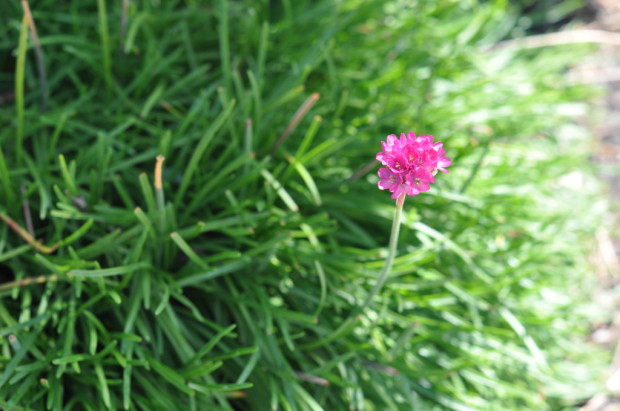Visiting the outer AVAs
On Day 4 of touring Lodi we focused primarily on traveling the regions that circle the Mokelumne River. Heading East, the land rises in undulating curves towards the Sierra Foothills, heading North the ground lifts in a mesa giving an elevated while still flat presentation. The ground heading North and East takes on more rocks and silt compared to the sandy ground of the Mokelumne. The Lodi AVAs as a whole also celebrate a coastal influence, receiving cooling breezes through the gap on the Northern edge of Mt Diablo, with air from the ocean, and bay pushing over the entire Lodi region. As a result, the Lodi area is cooler than the rest of the Central Valley. The delta breeze lessens in the Northeastern AVAs, however, with a slightly higher temperature range there as a result.
Touring and Tasting with Markus Bokisch: Clements Hills, Borden Ranch, Sloughhouse AVAs
We met Markus Bokisch at his vineyard office in the Clements Hills, east of Lodi. Markus grows vines through multiple sub-AVAs throughout the Lodi region, and also makes wine under the Bokisch label. After tasting through a portion of his portfolio we went through a driving tour of the three other appellations.
Markus Bokisch’s family originates from Spain, where he continues to spend time during part of the year. In his vineyard office rests a grain thresher sled from the Pyrenees made of limestone chips and repurposed metal–bits of horseshoe and old saw blades could be seen in the strips.
We began by tasting through Bokisch Vineyards wines. The line up keeps an Iberian focus offering great value throughout. Here: Albarino, Garnacha Bianca, Monastrell, Tempranillo, Graciano. The wines are all made from Bokisch Vineyard fruit.
Traveling through the outer AVAs of the Lodi region include large bands of golden grasses. These stretches are largely protected under federal laws. One of the peculiar aspects of land development in the Central Valley region is protection of vernal pools. Here Markus stands on the edge of a vernal pool. The soils through the region develop a hard pan just below the surface that makes it difficult for plant roots to go very deep, but also for water to drain. As a result rains pool in low spots (here seen through the color variation of the grasses–the lighter spots are evaporated pools) and the water, unable to drain, evaporates slowly. There is a wealth of plant and animal life native only to these pools. In the 1990s protections went into place after realizing many of these creatures were on the endangered species list. Agricultural development is now limited as a result with large swaths of land belonging to vernal pool easement zones.
Coyote Thistle grows in the same environmental conditions as the endangered fairy shrimp, thus serving as an indication of a pool area that likely also houses the shrimp.
In the Borden Ranch AVA the earth rolls in a slow climb to the Sierra Foothills, housing too large boulders and redder earth through the vineyards. Here Markus shows us one such rock.
Markus Bokisch
Markus is currently developing a new vineyard site in the Sloughhouse AVA, a region that stands at slightly higher elevation, with more hill effects, and a little less wind than the other regions. The ground is dominated by boulders. Looking over a high point in his upcoming Sheldon Hills Vineyard.
Tasting Cochon and Odisea with Adam Webb
Adam Webb tasted us through his Odisea (Iberian focused) and Cochon (French focused) wines over lunch. He sources fruit from multiple regions in California but especially from the Lodi AVAs, including several of Markus Bokisch’s vineyards, and Ron Silva’s SilvaSpoons. The wines all offer a juicy, flavorful, light touch presentation of the fruit.
the white and rosé line up from Cochon and Odisea.
the red line up from Odisea and Cochon
Drinking Italian at Sorelle Winery
After developing California windmill technology, Mike Scott invested in developing a new vineyard at the southern most boundary of the Lodi AVA, just north of Stockton leading to what is now known as Sorelle Winery.
At the Dodge House property, Sorelle grows 3/4 acre of Sangiovese (shown here), and 3/4 of an acre of Barbera. They also source small portions of fruit from other vineyards.
The Sorelle label focuses entirely on Italian style wines (including a Super Tuscan inspired blend).
Looking into the Barbera vines.
Sorelle Winery
Visiting Silva Spoons Vineyard in Alta Mesa AVA 
In the Alta Mesa AVA, north of Lodi, Ron Silva has developed his SilvaSpoons Vineyard offering a mix of Bordeaux varieties but specializing in Portuguese grapes. His family originates in Portugal, where he also visits, and as he explains, he wants to connect to what his family ate and drank. As part of that he grows Portuguese grapes here, and offers what is one of the more diverse collections of vines from that region in California. Here Ron shows us his newly planted Alvarelho.
The Silva Spoons Vineyard has an impressive number of Portuguese varieties growing, including here the Trincadeiro near the house.
Looking into the Trincadeiro.
Ron’s vineyards are all sustainably farmed. He produces his own compost for the vineyards.
Discussing the Torrontes. Ron grows the only Torrontes vineyard in North America.
Torrontes
He also keeps cattle, and a few Berkshire pigs.
For dinner Ron served us traditional Portuguese food. Here he makes his bacalhau–dried cod soaked, then mixed with potato, olive oil (made from Ron’s own trees), egg, and olives.
beginning to taste whites made with Silva Spoons fruit. The Alta Mesa label is Ron’s.
Starting dinner with friends outside.
Tasting reds made from Silva Spoons fruit.
Finishing dinner with a Portuguese night cap.
***
Thank you to Randy Caparoso.
Thank you to Markus Bokisch.
Thank you to Adam Webb.
Thank you to Ron Silva and Kathy.
Copyright 2013 all rights reserved. When sharing or forwarding, please attribute to WakawakaWineReviews.com.




























You captured the essence of that magical day in your words and your pictures.
Salut!
Thank you, Markus. It was a great tour of those AVAs.
This sounds like a nice & informative trip to Lodi for you, but as a consumer I have to wonder about its worth to me (and I am already a fan of several of the winemakers you visited). I know this is a blog, and the standards are not the same as other types of journalism, but I am left wondering just what was reported here in these 4 posts except that you had a nice time. I also wonder if this favorable treatment that you received from those folks will compromise any future reviews you may write of their wines. Was any objectivity lost in this glowing reporting? Just being honest here.
Hi Patrick,
Thank you for your comment.
In the midst of a 5 day tour with a minimum of 12 hour days (most were longer), there is no time to do intensive write ups on the wines, the people, or the place. When traveling like this, I post photos so people can see a portion of where I have been. It’s a way of sharing something of the region when there is no time to give more in depth information or analysis. The photo posts alone take several hours to get up. So, at the end of a 12+ hour day, getting photos online with accurate captions and location information is the best I can do.
These sorts of trips are pretty standard for wine writers. The only way to meet people and interview them for their larger story, and hear the specifics about their winemaking is to have direct contact in this sort of way. I am very grateful for the opportunity. It is also the only way for me to be able to then later give thorough going insight into a region or someone’s winemaking history. So, your question of objectivity is the same to pose to travel writers or wine writers generally. Sharing a lunch, or vineyard visit is a different thing than being paid to write about particular producers.
I have not written more on Lodi wine yet because I am in the midst of doing a lot of follow up tastings and interviews with people that were not included in last week’s visit, and others from outside the region too. I’ll start posting more in depth consideration once that has been completed. So, there has been no glowing reporting here yet. Though I am quite open with my appreciation for the time I share with people. These visits I do are a lot of genuine work and I’m quite grateful to get to do it.
Thanks for your questions.
Elaine